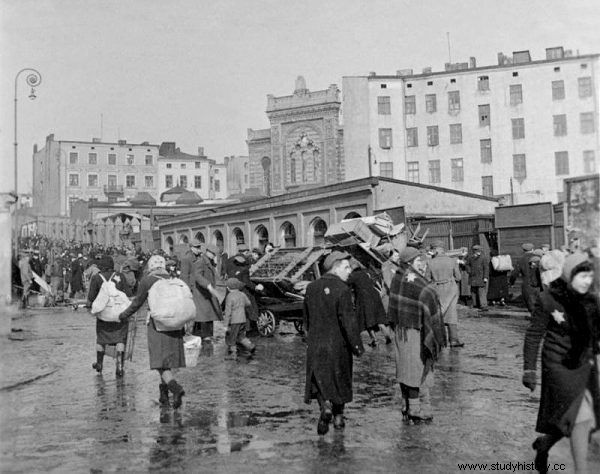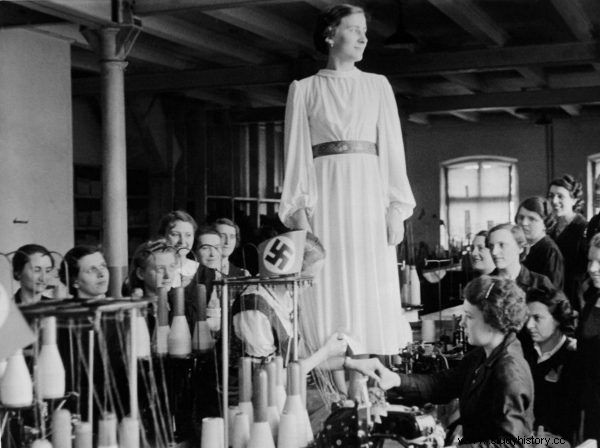As seen through the eyes of a child, anti-Semitism is not only abstract, unimaginable and cruel. From an early age, young Leon met the worst. Today, as an adult, he tries to warn others and save the history of people like him from oblivion. Can you come to terms with hell?
Living in a world where nascent anti-Semitism came to the fore was extremely difficult. Especially when the world was seen through the eyes of a child who did not understand what was happening. Leon Weintraub was such a child. His story is told in the latest book by him and Magda Jaros, "Reconciliation with evil. A story of a boy from the Lodz ghetto ”.
Leon has many memories of his early youth. They are mixed. A loving mother, quite a lot of pampering. But there are also many cruel events. The ones that the young boy couldn't explain to himself.
“I have one more unpleasant memory related to my origins. Once I come out of the laundry onto our street and I see a Jew running away. A man with a revolver is running behind him. In front of my eyes, he shoots one, two, three ... A pool of blood is forming on the pavement, fragments of the body are lying ... The bandit's name was Szaniawski, one day he shot several Jews. He had a noisy trial in Łódź. ”
The beginning of hell
Leon spent the summer of 1939 planning the future. Happy and full of hope for what his return to school will bring him. At that time, Łódź was inhabited by about 600,000 people. About 1/3 of them were Jews, whose lives were about to change forever.
The occupation of the city by the Germans ran extremely smoothly. The first attacks were carried out on September 1, and offices and authorities were evacuated on the 6th day. The townspeople went to save Warsaw. On September 9, German soldiers were already walking along the streets of Łódź. On September 13, Adolf Hitler himself drove through one of the main streets in the city. Soon after that, this street was named after him.
I have two memories of the beginning of the war, both drastic.
First, as the Germans seized Łódź without a shot. The city was surrendered, white flags were displayed. The march of the Wehrmacht troops on Piotrkowska Street was very impressive. The cobblestoned shoes on the cobblestones sounded terrifying.
I was thirteen, not tall. The large young soldiers, bursting with health and strength gave the impression that nothing could resist them. They radiated such power that I was convinced they would destroy anything in their path. It inspired not respect, not admiration, but fear - that nothing could be stopped from this crushing force.

An official announcement in December 1939 ordered all Jews to pack one suitcase with their belongings and move to designated areas of the city.
An official announcement in December 1939 ordered all Jews to pack one suitcase with their belongings and move to designated areas of the city. As Leon Weintraub recalls:
It was an area inhabited by the poor:Bałuty and the vicinity of the Old Market Square. The word ghetto has not yet been spoken. Already on April 30, 1940, a fence with barbed wire entanglements was erected around the district. 160,000 people were crammed into just over four square kilometers. About 30,000 apartments were put at their disposal, of which only less than four hundred had sewage systems.
It was widely proclaimed that the Jews would be needed by the Third Reich as long as their work was profitable.
Litzmannstadt Ghetto
As early as April 1940, the displaced Jews in Łódź were imprisoned in the ghetto. Leon Weintraub remembers this as a strange creation in which two extremes coexisted.
In the beginning, there were schools, hospitals, a post office, a Community Center, where concerts were held, and newspapers were published. There was a fire brigade, old people's homes, orphanages and camps.
On the other hand, Jews were dying of hunger or exhaustion, working in the ministries created by Biebowo and Rumkowski. Deportations to Kulmhof, that is Chełmno na Nerem, were a daily reality. The Displacement Commission appointed by Rumkowski appointed people to the so-called contingent for death. On average, it was about a thousand people a day.

The text was created, among others based on the book by Leon Weintraub and Magda Jaros, "Reconciliation with evil", which has just been published by Bellona. Buy now
The ghetto worked until August 1944. According to Szewach Weiss, who wrote the introduction to the book by Elżbieta Cherezińska, “I was Rumkowski's secretary. The Journals of Etka Daum ”, Jews contributed 81,962,650 marks to the budget of the Third Reich. Of which over 14 million came from their confiscated property.
Non-everyday life
Loen Weintraub remembers the time spent in the ghetto as overwhelming with helplessness. Barbed wire, a duty of obedience, apartments too small for the crowded inhabitants. "I knew that if I wanted to survive, I had to shrink, be invisible," he recalls.
Leon ended up in metal factories, where his first task was to varnish iron discs and pack them in boxes. His working day lasted 12 hours. As a clever boy, he decided to make this job a little easier - and it could even cost him his life. Fortunately, he was punished instead. How does he recall his torturers?
The head of the department was Mr. Chimowicz, I was led to see him. He measured a few cheeks. Then Hans Biebow himself showed up. This is one of the few names of my pursuers that I have remembered. Nobody introduced himself, no SS man in the camp or capo. I admire those who cite the names of the torturers; they read it rather than remember it.

A tailor's shop (1940) in the Łódź ghetto.
I personally met a man who was involved in murdering people in towns near Łódź. Handsome, slender blond hair. I was sure it was my last hour . I knew the word "sabotage", I knew what awaited me because of it. I was short, physically twelve years old. Maybe it saved me? Chimowicz and Biebow noticed the boy's stupidity, they understood that I wanted to improve my work, but it turned out badly. As a punishment, I was transferred to a tinsmith.
In a sheet metal shop, he worked without good-quality protective equipment and devices. As a result, his hands were covered with deep wounds. Despite these injuries and terrible conditions, Leon was lucky. He never saw a doctor. His mother treated all ailments.
Just getting into the Lodz ghetto is too much for a young boy. It's too much for anyone! But these events were only the introduction to Hell. Already in 1942, the Great Szpera was ordered. Within a few days, 15,000 people were deported from the ghetto.
Leon's further life grew harder and harder. Not only the concentration camps left a mark on him, but also what happened to him much later. Despite great suffering, he has one message for us: "Goodwill, mutual respect and a willingness to make concessions are indispensable conditions for a successful dispute resolution."
You will get to know the story of Leon Weintraub in the latest book "Reconciliation with evil. A story of a boy from the Łódź ghetto ”, which has just been released by the Bellona publishing house.
Literature:
- Ewelina Karpińska-Morek, Soszka. The children did not dream of war , Krakow 2020.
- Leon Weintraub, Magda Jaros, Reconciliation with evil , Warsaw 2021.
- Szewach Weiss, introduction to:Elżbieta Cherezińska, I was Rumkowski's secretary. Etka Daum's Journals , Poznań 2008.
